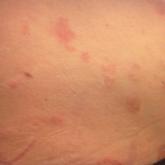Article

Autoimmune Progesterone Dermatitis
- Author:
- Ivy DeRosa, DO
- Brett Bender, DO
- Michael Centilli, DO
Article
Erythematous patches on the hands
- Author:
- David A. Kasper, DO, MBA
- Michael Centilli, DO
- Kimball Silverton, DO
Our patient’s history of obsessive-compulsive disorder may have masked the true diagnosis for years.
